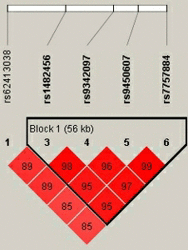Correlation of EYS polymorphisms with lumbar disc herniation risk among Han Chinese population
- PMID: 31359629
- PMCID: PMC6732306
- DOI: 10.1002/mgg3.890
Correlation of EYS polymorphisms with lumbar disc herniation risk among Han Chinese population
Abstract
Background: Lumbar disc herniation (LDH) is a common spinal disease in clinical practice. Once lumbar disc herniation occurs, it seriously reduces patient's quality of life. The EYS (eyes shut homolog) was discovered in recent years and it may be related to lumbar disc herniation. So we conducted a case-control study to explore the relationship between EYS polymorphism and lumbar disc herniation risk.
Methods: We selected 5 single-nucleotide polymorphisms (SNPs) of EYS gene in a case-control study with 508 cases and 508 healthy controls to evaluate the relatedness by using genetic model, haplotype, and stratification analysis.
Results: We found that the minor alleles of rs62413038 (OR = 1.21, 95%CI: 1.01-1.43, p = .036) and rs9450607 (OR = 1.26, 95% CI: 1.05-1.53, p = .016) were associated with an increased risk of lumbar disc herniation in the allelic model analysis. In the genotypic model analysis, rs62413038 displayed a significantly increased risk of lumbar disc herniation in log-additive models (OR = 1.20, 95% CI: 1.01-1.43, p = .039). While the rs9450607 was also obviously associated with an increased lumbar disc herniation risk in recessive (OR = 1.98, 95% CI: 1.24-3.13, p = .004) and log-additive models (OR = 1.27, 95% CI: 1.05-1.55, p = .014). In addition, in the haplotype analyses of the SNPs, we found that the "CGGA" haplotype of rs1482456, rs9342097, rs9450607, and rs7757884 was associated with lumbar disc herniation. (OR = 0.52, 95% CI: 0.30-0.89, p = .017).
Conclusion: These results suggest that EYS polymorphism may be associated with lumbar disc herniation among Han Chinese population. It also opens up a new exploration direction for the etiology of lumbar disc herniation.
Keywords: EYS; Case-control study; Lumbar disc herniation (LDH); Single-nucleotide polymorphism (SNP).
© 2019 The Authors. Molecular Genetics & Genomic Medicine published by Wiley Periodicals, Inc.
Figures
Similar articles
-
Association of GSDMC polymorphisms with lumbar disc herniation among Chinese Han population.Int J Immunogenet. 2020 Dec;47(6):546-553. doi: 10.1111/iji.12488. Epub 2020 Apr 24. Int J Immunogenet. 2020. PMID: 32333499
-
Association of glypican-6 polymorphisms with lumbar disk herniation risk in the Han Chinese population.Mol Genet Genomic Med. 2019 Jul;7(7):e00747. doi: 10.1002/mgg3.747. Epub 2019 May 20. Mol Genet Genomic Med. 2019. PMID: 31111662 Free PMC article.
-
RAB40C gene polymorphisms rs62030917 and rs2269556 are associated with an increased risk of lumbar disc herniation development in the Chinese Han population.J Gene Med. 2021 Apr;23(4):e3252. doi: 10.1002/jgm.3252. Epub 2021 Mar 17. J Gene Med. 2021. PMID: 32656896
-
Gene polymorphisms and expression levels of interleukin-6 and interleukin-10 in lumbar disc disease: a meta-analysis and immunohistochemical study.J Orthop Surg Res. 2020 Feb 18;15(1):54. doi: 10.1186/s13018-020-01588-8. J Orthop Surg Res. 2020. PMID: 32070384 Free PMC article.
-
Genetics of intervertebral disc disease: A review.Clin Anat. 2022 Jan;35(1):116-120. doi: 10.1002/ca.23803. Epub 2021 Nov 1. Clin Anat. 2022. PMID: 34689354 Review.
Cited by
-
Dissecting the role of EYS in retinal degeneration: clinical and molecular aspects and its implications for future therapy.Orphanet J Rare Dis. 2021 May 17;16(1):222. doi: 10.1186/s13023-021-01843-z. Orphanet J Rare Dis. 2021. PMID: 34001227 Free PMC article. Review.
-
Assessment of MIR3142HG genetic polymorphisms and the susceptibility of lumbar disc herniation in the Chinese population.Sci Rep. 2024 Nov 28;14(1):29542. doi: 10.1038/s41598-024-80758-8. Sci Rep. 2024. PMID: 39604548 Free PMC article.
-
Incidence of and risk factors for lumbar disc herniation with radiculopathy in adults: a systematic review.Eur Spine J. 2025 Jan;34(1):263-294. doi: 10.1007/s00586-024-08528-8. Epub 2024 Oct 25. Eur Spine J. 2025. PMID: 39453541 Free PMC article.
References
-
- Casa, N. L. , Casa Junior, A. J. , Melo, A. V. , Teodoro, L. S. , Nascimento, G. R. , Sousa, A. F. , … Curado, M. P. (2016). CASE‐REPORT Association between an ACAN gene variable number tandem repeat polymorphism and lumbar disc herniation: A case control study. Genetics and Molecular Research, 15, 10.4238/gmr15048867 - DOI - PubMed
-
- Fuchs, O. , Gorlanova, O. , Latzin, P. , Schmidt, A. , Schieck, M. , Toncheva, A. A. , … Frey, U. (2017). 6q12 and 11p14 variants are associated with postnatal exhaled nitric oxide levels and respiratory symptoms. The Journal of Allergy and Clinical Immunology, 140, 1015–1023. 10.1016/j.jaci.2016.11.048 - DOI - PubMed
Publication types
MeSH terms
Substances
Supplementary concepts
LinkOut - more resources
Full Text Sources
Medical


